Matias, E., MacKenzie, I. S., & Buxton, W. (1993). Half-QWERTY: A one-handed keyboard facilitating skill transfer from QWERTY. Proceedings of the ACM Conference on Human Factors in Computing Systems - INTERCHI '93, pp. 88-94. New York: ACM. doi:10.1145/169059.169097. [PDF]
Half-QWERTY: A One-handed Keyboard Facilitating Skill Transfer From QWERTY
Edgar Matias1, I. Scott MacKenzie2, & William Buxton3
1The Matias Corporation600 Rexdale Boulevard, Suite 1204
Toronto, Ontario, Canada M9W 6T4
(416) 675-3092 edgar @ halfkeyboard.com
2Dept. of Computing and Information Science
University of Guelph
Guelph, Ontario, Canada N1G 2W1
(519) 824-4120 mac @ snowhite.cis.uoguelph.ca
3University of Toronto & Xerox PARC
c/o Computer Systems Research Institute
University of Toronto
Toronto, Ontario, Canada M5S 1A4
(416) 978-1961 buxton @ dgp.toronto.edu
Abstract
Half-QWERTY is a new one-handed typing technique, designed to facilitate the transfer of two-handed typing skill to the one-handed condition. It is performed on a standard keyboard, or a special half keyboard (with full-sized keys). In an experiment using touch typists, hunt-and-peck typing speeds were surpassed after 3-4 hours of practice. Subjects reached 50% of their two-handed typing speed after about 8 hours. After 10 hours, all subjects typed between 41% and 73% of their two-handed speed, ranging from 23.8 to 42.8 wpm. These results are important in providing access to disabled users, and for the design of compact computers. They also bring into question previous research claiming finger actions of one hand map to the other via spatial congruence rather than mirror image.Keywords: Input devices, input tasks, human performance, one-handed keyboard, QWERTY, portable computers, disabled users, skill transfer.
Introduction
The idea of a one-handed keyboard is not new. As early as 1968, Engelbart and English [2] used a one-handed chord keyboard in conjunction with a newly developed input device -- the mouse. The user entered text with one hand, while using the mouse to enter spatial information with the other. However, unlike the mouse, acceptance of one-handed keyboards has been limited to very specific applications, such as keyboards for the disabled. There are several reasons for this, but chief among them is the need to learn a new typing technique. For most people, the benefit of touch typing with one hand is not worth the cost of learning to do it.This paper describes a new approach to one-handed text entry which exploits the skills already developed in two-handed typing. It is called, "Half-QWERTY," because it uses only half of the QWERTY keyboard. The technique can be used on an unmodified standard QWERTY keyboard (using only half of the available keys, Figure 1), or with a special half keyboard (Figures 2 & 3). The former provides wide access to the technique. The latter provides a compact keyboard with full-sized keys supporting touch typing on portable computers, for example.
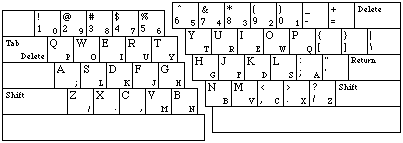
Figure 1. Left- and right-hand Half-QWERTY
layouts on a standard QWERTY keyboard.
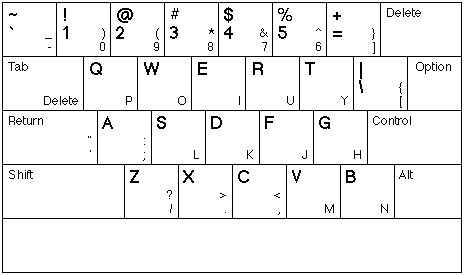
Figure 2. Left-hand portable keyboard (actual size). When a key is depressed,
the character in the upper left of the key is entered. When preceded by holding down
the space bar, the character in the lower right is entered.
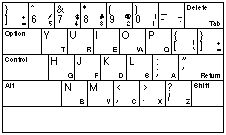
Figure 3. Right-hand portable keyboard. When a key is depressed,
the character in the upper left of the key is entered. When preceded by
holding down the space bar, the character in the lower right is entered.
The present study examines the degree to which skill transfers from QWERTY to Half-QWERTY keyboards.
The Half-QWERTY Concept1
Most one-handed keyboards are chord keyboards. Half-QWERTY is not. The design builds on two principles:
- A user's ability to touch type on a standard QWERTY keyboard.
- The fact that the human hands are symmetrical -- one hand is a mirror image of the other.
A Half-QWERTY keyboard is comprised of all the keys typed by one hand, with the keys of the other hand unused or absent. When the space bar is depressed, the missing characters are mapped onto the remaining keys in a mirror image (Figure 1), such that the typing hand makes movements homologous to those previously performed by the other hand. Thus, using the space bar as a modifier, a typist can generate the characters of either side of a full-sized keyboard using only one hand.
Depressing and releasing the space bar within a timeout generates a space character. The timeout reduces the number of erroneous spaces generated as a side-effect of using the space bar as a modifier key. It is often the case that a typist will depress the space bar with the intention of mirroring the state of another key but then change their mind and release. Without the timeout, such actions would result in an unwanted space character. For this experiment, the timeout was 16/60 seconds, or 267 ms.
Modifier keys (such as shift and control) are supported via a "latch" mechanism, commonly known as "Sticky Keys." Depressing and releasing a modifier key once activates it for the next key pressed. Depressing it twice locks that key until it is unlocked by depressing it again. Sticky Keys allows one finger to do the work of several, when performing key sequences that would otherwise require the simultaneous depression of two or more keys.
Application and Implementation
The original objective of this design was to establish a keyboard for palmtop computers: one that was small yet permitted touch typists to use their existing skills. Prior efforts tended toward reducing the size and spacing of the keys of standard QWERTY [18]. Such attempts are problematic since they lead to keyboards that are too small to accommodate two hands. We have side-stepped this by requiring only one hand for typing. However, the idea is versatile, and has more applications.Using a Half-QWERTY keyboard in one hand, and a pointing device, such as a mouse, in the other recaptures the two-handed flavour of Engelbart and English's system [2]. Text can be entered with one hand, and items selected and manipulated with the other. Since both hands are in "home position" for their respective task, no time is lost in moving between devices. Furthermore, by implementing the Half-QWERTY keyboard on a standard keyboard, one can easily switch between this type of input and two-handed typing. Finally, since each side of the keyboard is mapped onto the other side when the space bar is depressed, the user can choose which hand to use for one-handed typing. In effect, the user has a choice of three keyboards in one: a two-handed QWERTY keyboard, and two Half-QWERTY keyboards, one for each hand. All of this we have achieved entirely in software. This is especially beneficial to disabled computer users, since it obviates the need for specialized hardware.
Which Hand to Use?
Given the keyboard described above, we must now decide which hand is 'best' for one-handed typing. In general, we believe this is the non-dominant hand. This would free the more dexterous dominant hand to use a mouse (or other device) to enter spatial information. This arrangement would work especially well on a palmtop computer. For example, the computer could open horizontally, like a wallet (Figure 4), thus keeping the keyboard comfortably to the side (where the hand is) and the screen in the centre (where the eyes are). If equipped with a touch screen, concurrent entry of text and graphics is possible. Note also that the left-hand and right-hand versions of Half-QWERTY are physically identical (Figures 2 & 3), differing only in their key cap markings and the mappings. So, a left-hand typist can easily adapt a right-hand keyboard for left hand use, and vice versa.

Figure 4. Various screen placements for left- and right-hand
palmtop computers equipped with Half-QWERTY keyboards.
Furthermore, two-handed typing can be performed using two of these half keyboards together. This has the added benefit of allowing the user to adjust each keypad independently to whichever position is most comfortable.
Wearable Computers
A computer that is worn, rather than carried, has significant advantages for data collection "in the field." By eliminating infrequently used keys (e.g., the number keys) and reducing the size of the space bar, a Half-QWERTY keyboard can be made small enough to wear on the wrist of the dominant hand. With an LCD screen worn on the other wrist, the resulting typing posture allows the user to type and view the screen, simultaneously. Note that this arrangement is consistent with the convention of wearing one's wrist watch on the non-dominant arm.Such a computer would be extremely portable, allowing fast data entry without the need of a table or other supporting surface required by most computers today. Data could even be entered while standing or walking.
Hand Symmetry vs. Spatial Congruence
Half-QWERTY is based on the principle that the human brain controls typing movements according to the finger used, rather than the spatial position of the key. Thus, the finger used to hit a key is the critical invariant -- the critical similarity that is maintained across the training and transfer tasks -- in the transfer of skill from QWERTY to Half-QWERTY. Lintern [8] writes:If critical invariants (specifically, those that pose a meaningful learning challenge) remain unchanged, [skill] transfer will be high even when many other features of the environment, context, or task are changed ... If an operator's perceptual sensitivity to critical invariants can be improved, that enhanced sensitivity will serve to facilitate transfer. (p. 262)
The mirror image encoding scheme (described above) follows from this. A rival encoding scheme is that of spatial congruence, which maintains that the spatial position of the key is the critical invariant. There is disagreement in the literature as to which of these schemes is 'better.' In the context of this experiment, we believe mirror image mapping is preferred.
Grudin [7], in his analysis of error patterns in transcription typing, found that homologous substitution errors are among the most common errors. These occur when the character corresponding to the mirror image position on the keyboard, is substituted for the one required. For example, substituting D for K (middle finger of either hand) is a homologous error. These findings, which were confirmed by Munhall and Ostry [10], suggest a predisposition among QWERTY typists to mirror image mapping.
During the evaluation of a one-handed chord keyboard, Rochester, Bequaert, and Sharp [17] trained one student using the right hand only. The subject was later retrained to type with the left hand only. The subject "reached close to his right-hand typing speed in less than one third the time he spent learning right-handed typing" (p. 62). Their left-hand keyboard was a mirror image of the right-hand version.
Gopher, Karis, and Koenig [5] trained subjects on a two-handed chord keyboard and then investigated whether the skill thus acquired transferred to the other hand by mirror image or spatial congruence. Their conclusions suggest that spatial congruence is the dominant mapping. They also tested a third condition, a combination of the two, using keyboards mounted vertically rather than horizontally. Hand-to-hand mapping was best in this condition.
This suggests that spatial congruence was stronger than mirror image mapping, which would seem to contradict what we have argued above. However, closer inspection reveals that the combined scheme was actually the equivalent of the mirror image keyboard, but with a vertical rather than flat posture (i.e., with the hands positioned as though playing a saxophone, as opposed to a piano).
Furthermore, despite the efforts of Gopher et al. [5] to keep error rates low, the errors that did slip through were primarily homologous errors made by subjects using the spatial congruence keyboard. This suggests a predisposition among chord keyboard typists to mirror image mapping.
In the following section, we describe an experiment intended to test the degree to which skill transfers from QWERTY to Half-QWERTY keyboards, among skilled touch typists.
Method
Subjects
Ten right-handed, computer literate, QWERTY typists from a local university served as paid volunteers. Subjects used their non-dominant (left) hand when typing with one hand. The Edinburgh Inventory [13] was used to determine handedness.Equipment
Tasks were performed on Apple Macintosh II and IIci computers using a standard Apple keyboard. A cardboard shield was placed between the keyboard and the subjects' eyes in order to prevent them from looking at the keyboard.Procedure
Each subject performed 10 sessions, with no more than one session per day. Each session contained a two-handed pretest, multiple blocks of one-handed typing, and a two-handed post-test. The first session included a few specially prepared one-handed blocks, designed to ease subjects into understanding the operation of the keyboard. All one-handed typing was performed with the left hand.The interface was similar to that of Typing Tutor IV 2 with the subject's typing displayed beneath the input text. The delete key was disabled so subjects could not correct errors. A beep was heard for every error made. Subjects were instructed to type as quickly and accurately as possible, while remaining in sync with the input text. They could rest as desired between blocks.
The text for all typing was taken from a novel about Japanese-American relations. It contained only upper and lower case letters, and simple punctuation (comma and period).
Design
This experiment is an investigation of the learning potential of the Half-QWERTY keyboard. Each 50 minute session consisted of a series a text blocks typed by the subject. The block length was set to 60 characters by 4 lines in the first session (using Courier 14 point type), and was increased to 6 lines when subjects managed to type 30 one-handed blocks in one session. Subjects completed as many blocks as were possible in a session, ranging from 7 to 35 blocks, depending on speed and the amount of rest.The dependent measures were typing speed and error rate. Typing speeds are given in words per minute (wpm), with a word defined as 5 characters (4 letters plus a space). Error rates are given as a percentage of total keystrokes (the lower the better). Subjects had to type the correct character in the correct position. Thus, they had to type in sync with the text on the screen. If they fell out of sync, it was considered an error (as consistent with Typing Tutor IV).
Complete keystroke level data were also collected which allowed for a detailed examination of interkey timings across states (space-up, space-down) and fingers, and of error patterns across letters and state sequences. Due to space limitations, these analyses are not provided in the present paper.
Results
Subjects were able to adapt to Half-QWERTY typing very quickly. As shown in Figure 5, session 1 resulted in an average speed of 13.2 wpm, with over 84% accuracy. This performance is impressive, especially considering how little training was given. For instance, subjects were not required to memorize the layout before starting the one-handed typing task, and therefore had to rely entirely on skill transfer from two-handed typing.
Session ----------------------------------------------------------- Measure Hands 1 2 3 4 5 6 7 8 9 10 ---------------------------------------------------------------------------- Speed 1 3.2 18.3 21.1 24.4 27.1 29.0 30.7 31.6 33.6 34.7 (wpm) 2 58.5 59.8 62.3 61.6 63.7 63.3 64.0 64.6 66.2 64.9 Errors 1 15.96 12.13 9.93 9.70 9.21 8.98 7.55 8.23 7.54 7.44 (%) 2 3.25 3.40 2.45 3.05 3.40 3.55 3.55 3.55 3.30 4.20 |
on one-handed and two-handed typing over 10 sessions.
One-handed speed improved significantly over the ten sessions (F9,81 = 80.7, p < .0001) to reach a tenth session average of 34.7 wpm. Improvement in one-handed error rate was also statistically significant (F9,81 = 14.6, p < .0001) dropping to an average of 7.44% errors in the tenth session. This is approximately double the rate of errors made in two-handed typing.
As Figures 6 and 7 show, one-handed performances varied a great deal among subjects. For example, subject 6 averaged 19.5 wpm in session 1. Subject 7 did not reach a comparable speed until session 6. Many factors likely contribute to this disparity among subject performances: two-handed speed and accuracy, regularity of practice, etc.
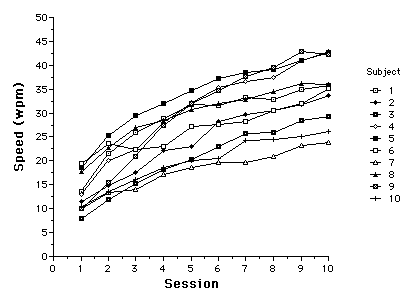
Figure 6. One-handed typing speed by subject and session.
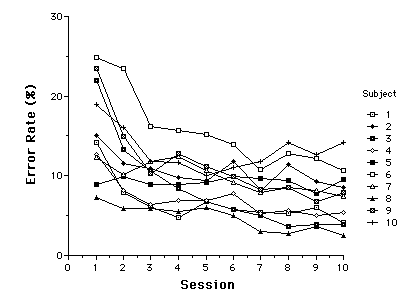
Figure 7. One-handed typing error rates by subject and session.
Note that none of the subjects had peaked by session 10, even though three of them were typing in the low 40 wpm range. Subjects 5, 8, and 9 have agreed to undergo further long-term testing to determine what possible peak speeds can be achieved. These tests, which are on-going, indicate a potential for touch typists to achieve 88% (or more) of their two-handed speed.
Also worthy of note is that two-handed typing speeds improved significantly over the ten sessions (F9,81 = 4.43, p < .0001). This is likely due to subjects getting accustomed to the software and the feel of the keyboard. One-handed typing may also have had an effect. There was no significant reduction in two-handed error rates over the ten sessions (F9,81 = 1.12, p > .05).
Discussion
On average, subjects were able to exceed hunt-and-peck typing speeds after about 3-4 hours. Wiklund et al. [18] determined the average speed for one-handed hunt-and-peck typing on a standard keyboard to be approximately 23 wpm. Performances on the different compact keyboards tested were considerably worse. They ranged from 15-21 wpm, depending on key type, size, and spacing. Our subjects were typing in this range in less than two hours of practice, and exceeded 50% of their two-handed speed after about 8-9 hours of use. This is comparable to Wiklund et al.'s [18] measure of average handwriting speed (33 wpm). By the tenth session, subjects were typing between 41% and 73% of their two-handed speed. These speeds ranged from 23.8 to 42.8 wpm. This is strong evidence that skill transfers hand-to-hand by mirror image and not spatial congruence.It is instructive to compare these results to the learning curves of chord keyboards. Gopher and Raij [6] tested subjects' rate of skill acquisition on both one-handed and two-handed chord keyboards, as well as standard QWERTY. After 10 hours, the one-handed group was typing at approximately 21 wpm and the two-handed group at 22 wpm. This compares to the Half-QWERTY subjects' tenth session average of 34.7 wpm. Gopher et al.'s [6] one-handed and two-handed subjects did not reach comparable rates until the sessions 29 and 26, respectively. Therefore, from an economic standpoint, it is more cost effective for a QWERTY typist to adopt the Half-QWERTY technique than to learn to type on a one-handed chord keyboard.
Gopher et al. [6] also found that until about session 25, two-handed performance was only slightly better than one-handed performance on their chord keyboard. This begs an interesting question: What percentage of two-handed speed can be achieved with one hand? This, of course, is not yet known, but we feel it may be as high as 88%. The answer is likely different for chord and Half-QWERTY keyboards. More study is required.
Conclusions
We have shown that it is possible for QWERTY typists to achieve high one-handed typing rates (40+ wpm) in a relatively short period of time (< 10 hr) using the Half-QWERTY technique. These speeds are 2-3 times the rates achievable using compact keyboards, and exceed handwriting speeds. These high learning rates are due to the transfer of two-handed skill via Half-QWERTY's mirror image hand-to-hand mapping scheme.These results lead to new possibilities for human-computer interfaces. By exploiting standard two-handed typing skill and the Half-QWERTY concept described above, we have demonstrated the potential to build a keyboard with full-size keys, but no larger than a paperback book. Furthermore, since the design can be implemented in software, wide and convenient access to one-handed typing is also possible on a standard keyboard. These findings are important for designers of compact computing systems and systems for disabled users.
Acknowledgements
We would like to acknowledge the contributions of Jonathan Cheng who wrote the software and the Input Research Group at the University of Toronto who provided the forum for the design and execution of this project. In addition, we gratefully acknowledge the support of the Natural Sciences and Engineering Research Council of Canada, Digital Equipment Corporation, Xerox Palo Alto Research Centre (PARC), Apple Computer's Human Interface Group, IBM Canada's Toronto Laboratory Centre for Advanced Studies, and the Arnott Design Group of Toronto.References
[1] Buxton, W. (1990). Chord keyboards. The pragmatics of haptic input, Tutorial 26 Notes of CHI'90, 6.1-6.9.[2] Engelbart, D., & English, W. K. (1968). A research center for augmenting human intellect. Proceedings of the Fall Joint Computer Conference (pp. 395-410). Washington, DC: Thompson Book Co. https://doi.org/10.1145/1476589.1476645
[3] Gentner, D. R., Grudin, J. T., Larochelle, S., Norman, D. A., & Rumelhart, D. E. (1983). A glossary of terms including classification of typing errors. In W. E. Cooper (Ed.), Cognitive aspects of skilled typewriting (pp. 39-43). New York: Springer-Verlag. https://doi.org/10.1007/978-1-4612-5470-6_2
[4] Gentner, D. R. (1983). Keystroke timing in transcription typing. In W. E. Cooper (Ed.), Cognitive aspects of skilled typewriting (pp. 95-120). New York: Springer-Verlag. https://doi.org/10.1007/978-1-4612-5470-6_5
[5] Gopher, D., Karis, D., & Koenig, W. (1985). The representation of movement schemas in long-term memory: Lessons from the acquisition of a transcription skill. Acta Psychologica, 60, 105-134. https://doi.org/10.1016/0001-6918(85)90051-4
[6] Gopher, D., & Raij, D. (1988). Typing with a two-handed chord keyboard: Will the QWERTY become obsolete? IEEE Transactions on Systems, Man, and Cybernetics, 18, 601-609. https://doi.org/10.1109/21.17378
[7] Grudin, J. T. (1983). Error patterns in novice and skilled transcription typing. In W. E. Cooper (Ed.), Cognitive aspects of skilled typewriting (pp. 121-143). New York: Springer-Verlag. https://doi.org/10.1007/978-1-4612-5470-6_6
[8] Lintern, G. (1991). An informational perspective on skill transfer in human-machine systems. Human Factors, 33, 251-266. https://doi.org/10.1177/001872089103300302
[9] Litterick, I. (1981, January 8). QWERTYUIOP -- dinosaur in a computer age. New Scientist, pp. 66-68.
[10] Munhall, K. G., & Ostry, D. J. (1983). Mirror-image movements in typing. In W. E. Cooper (Ed.), Cognitive aspects of skilled typewriting (pp. 247-257). New York: Springer-Verlag. https://doi.org/10.1007/978-1-4612-5470-6_10
[11] Noyes, J. (1983). Chord keyboards. Applied Ergonomics, 14, 55-59. https://doi.org/10.1016/0003-6870(83)90221-1
[12] Noyes, J. (1983). The QWERTY keyboard: A review. International Journal of Man-Machine Studies, 18, 265-281. https://doi.org/10.1016/S0020-7373(83)80010-8
[13] Olfield, R. C. (1971). The assessment and analysis of handedness: The Edinburgh inventory. Neuropsychologica, 9, 97-113. https://doi.org/10.1016/0028-3932(71)90067-4
[14] Ostry, D. J. (1983). Determinants of interkey times in typing. In W. E. Cooper (Ed.), Cognitive aspects of skilled typewriting (pp. 225-246). New York: Springer-Verlag. https://doi.org/10.1007/978-1-4612-5470-6_9
[15] Potosnak, K. M. (1988). Keys and keyboards. In M. Helander (Ed.), Handbook of human-computer interaction (pp. 475-494). Amsterdam: Elsevier. https://doi.org/10.1016/B978-0-444-70536-5.50026-9
[16] Provins, K. A., & Glencross, D. J. (1968). Handwriting, typewriting and handedness. Quarterly Journal of Experimental Psychology, 20, 282-320. https://doi.org/10.1080/14640746808400162
[17] Rochester, N., Bequaert, F. C., Sharp, E. M. (1978, December). The chord keyboard. Computer, 57-63. https://doi.org/10.1109/C-M.1978.218024
[18] Wiklund, M. E., Dumas, J. S., & Hoffman, L. R. (1987). Optimizing a portable terminal keyboard for combined one-handed and two-handed use. Proceedings of the Human Factors Society -- 31st Annual Meeting -- 1987 (pp. 585-589). Santa Monica, CA: Human Factors Society. https://doi.org/10.1177/154193128703100524
Footnotes
1 Patents pending. International Application # PCT/CA90/00274 published March 21, 1991, under
International Publication # W091/03782.
2 Kriya Systems, Inc. Published by Simon & Schuster Software, Gulf+Western Building, One
Gulf+Western Plaza, New York, NY 10023, USA.